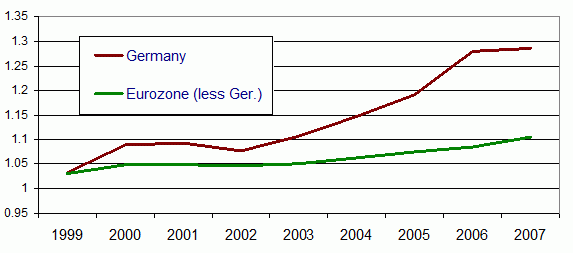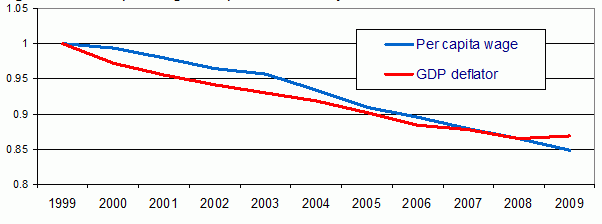Is Germany the model to imitate? If we consider its GDP growth in 2010 (more than 3.5%, against a rise of 1% in the rest of the Eurozone) and the success of its products in global markets, there should be no question. In Europe, so the argument goes, we should all try to do what the Germans do.
But this conclusion is based on a false reality. With its large and persistent trade surplus (7% of GDP on average since 2002), Germany is a generator of tensions, rather than stability, in the Eurozone. Its export-led model works, in part, at the expense of European partners, with around 60% of the surplus going towards the Eurozone (85% including the other EU member countries, see Figure 1)1. If all European countries tried to become like Germany, disruptive mercantilist attitudes would surely result.
Figure 1. Geographic distribution of German surplus - 2009
Source: Bundesbank
An asymmetric shock in the Eurozone
A virtuous phenomenon is at the origin of the German trade surplus – an extraordinary acceleration of productivity that allowed German firms and products to gain shares in world demand. However, technological progress was not diffused across all sectors of that economy. It concentrated in the manufacturing industry, which is fully exposed to international competition, while sectors with non-traded products were largely excluded. A similar sector gap characterised other Eurozone countries, but in those cases imbalances were much less dramatic. In Germany, manufacturing total factor productivity rose, in 2002-2007, by 19% relative to the stagnant level of the other sectors. In the rest of the Eurozone meanwhile, the divide was only 6% on average (8%, in terms of hourly productivity; see Figure 2).
Figure 2. Total factor productivity
Source: Euklems
This imbalance caused destabilising effects within Europe similar to those following German unification. In the early 1990s it was an asymmetric demand shock to disrupt the European Monetary System while in the 2000s it has been an asymmetric supply shock in the traded sector to strain the common-currency area. The relative price change of European countries, necessary for macroeconomic rebalancing, was determined in 1992 by a traumatic modification of exchange rates and an effective real appreciation of the deutsche mark. Nowadays, with the euro, the real-exchange-rate appreciation of the German currency can’t rely (hopefully) on the same process – instead it has to materialise through an increase of German inflation above the Eurozone partners.
What should have happened and… what actually happened
Without exchange rates, the adjustment mechanism should be brought about by the biased technological progress itself, as illustrated by such old, but insightful, two-sector schemes as the Scandinavian model and Balassa-Samuelson effect (see Swan 1963, Aukrust 1977, and Dornbusch 1980). Rise in demand for manufacturing goods and labour, induced by biased productivity shock, should lead to wage increases in that industry. The latter would diffuse to the (mostly sheltered) other sectors that did not benefit from gains in efficiency, causing there an increase of prices with respect to manufacturing and giving rise to an acceleration of inflation relative to other economies. This would permit the shift of relative prices to the new equilibrium compatible with restoration of internal and external balance.
But things in Germany went the opposite way. Per-capita wages in manufacturing did not rise with productivity. On the contrary, in 2002-2007 they dropped by 14.5% relative to the value of the average product of labour. In 2008-2009, there was a reversion of this trend, but it was largely a temporary phenomenon related to the crisis (in all countries profits were played as buffers in the recession), as subsequent movements of the wage share have shown (Figure 3).
Figure 3. German manufacturing: Per-capita real wage/labour productivity (wage share)
Source: Eurostat
Failing a wage boost from manufacturing, there was no significant rise of relative prices of sheltered sectors. Actually, relative prices increased much less in Germany than in the rest of the Eurozone (Figure 4). As a result German per-capita wages and prices, for the whole economy, declined by about 10% compared with their trade partners (Figure 5) and the European macroeconomic equilibrium moved further and further away. Indeed, adjustment would have required, given cross-country sectoral gaps in productivity trends, an almost mirror-like movement of German inflation relative to their partners2.
Figure 4. Relative price: Manufacturing/ other sectors (sector value added deflators)
Source: Eurostat
Figure 5. Per-capita wage and prices: Germany / rest of the Eurozone
Source: Eurostat
Depressive impulse and distortions in the Eurozone
What occurred in Germany was the result of internal political choices, democratic expression of preferences of the social actors of that country3. Yet in a fully integrated area without exchange rates, those choices have an influence on the neighbourhood. This is a sensitive matter of European governance largely ignored by the European discussion on the functioning of a monetary union and absent in the reform proposals of the Pact, only aware of negative-sign imbalances.
The missing German adjustment is depressing the Eurozone and is leading policymakers to attach too-large-a weight, fraught with distortions, to the role of manufacturing and exports for economic growth. Without a German rebalancing, the burden of re-equilibrium falls wholly upon the euro partners, who have to generate the required inflation differential, lowering their price and wage dynamics below the German ones. This is a negative impulse for the Eurozone. Negative output gaps inherited from the recession are doomed to perpetuate, while efforts towards fiscal correction of peripheral countries are made more and more difficult.
At the same time, the need to correct the imbalance has led policymakers to try – all at once – to repeat what has been done in Germany. By doing so they are emulating the manufacturing-biased expansion and neglecting productivity improvements in the other sectors. This is almost an inescapable path, but not a desirable one in the medium- to long-run. The bulk of expenditure by European citizens is not in transformed goods; most (about 60%) is devoted to services, distribution and public utilities, characterised by low efficiency and scarcely substitutable with imports. It follows that lagging progress in protected sectors imposes structural constraints to the purchasing power of consumers whose expenditures, not by accident, have stagnated during the entire euro experience.
If we are aiming to re-launch growth for the “old continent” citizens, while also providing fresh drive for European integration, copying Germany is not the right recipe. Strategy for growth should, instead, abandon the rhetoric on manufacturing – and the mercantilist drift it implies – and go back to settle the centre stage issue of the efficiency of the predominant service sector.
This column reflects the views of the author writing in a personal capacity.
References
Aukrust O. (1977), “Inflation in the Open Economy: The Norwegian Model” World wide inflation, eds. L. Krause and W. Salant, Washington, Brookings Institutions.
Boysen-Hogrefe J., Groll D. (2010), “The German Labour Market Miracle”, National Institute Economic Review, n.214, October.
Dornbusch R. (1980), Open Economy Macroeconomics, New York, Basic Books, Inc.
Swan T. (1963), “Longer Run Problems of the Balance of Payments”, The Australian Economy: a volume of readings, eds. A. Arndt and M. Corden, Melbourne Australia, Cheshire Press.
Sabbatini R., Zollino F. (2010), “Macroeconomic Trends and Reforms in Germany”, PSL Quartely Review, vol. 63 n.254, pp. 235-263.
Whyte P. (2010), “Why Germany is not a Model for the Eurozone”, Centre for European Reform
1 In the first 7 months of 2010 the share of German surplus vis-à-vis the Eurozone reduced somewhat, but it still represented by far the largest part of the imbalance (about 55%, 82% considering the other EU states).
2 A back-of-envelope estimate implies that, ceteris paribus, German prices should have risen by about 8%, in 2002-2009, relative to the Eurozone. This is obtained from the following relationship: German inflation – Eurozone (less German) inflation = exchange rate change Germany/Eurozone less Gemany (which is 0) + 0.60*[TFP increase of manufacturing relative to other sectors in Germany (+19.3%) – TFP increase in manufacturing relative to other sectors in the Eurozone less Ger. (+5.7%)], where 0.60 is the weight of non manufacturing goods in the expenditure basket of European citizens. It is assumed that productivity differentials computed on the Euklems database for the period 2002-2007 (last available figure) did not change in the two-year period 2008-09. Considering hourly labour productivity, instead of TFP, the inflationary gap necessary for rebalancing would be as much as 6%. The Eu-klems (growth-accounting) definition of the Eurozone includes Austria, Belgium, Finland, France, Italy, Germany, Greece, Ireland, Italy, Luxembourg, Netherlands, Portugal, Spain.
3 Sabbatini and Zollino (2010) discuss thoroughly the role of the German policy agenda, involving labour market reforms and other structural reforms, in leading to higher efficiency, wage moderation and falling wage share in manufacturing. These authors also point out how such reforms largely left out the service sector, inducing an internal imbalance of the kind described in the present article. An analysis on the performance of the German labour market during and after the recession and the relation with wage moderation of the years before is offered by Boysen-Hogrefe and Groll (2010). On a line quite close to the arguments put forward in the present article see a recent paper by Whyte (2010) and Financial Times articles on the issue by Wolfgang Munchau and Martin Wolf.






